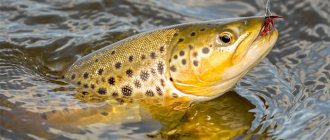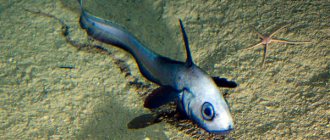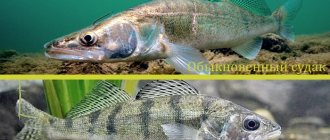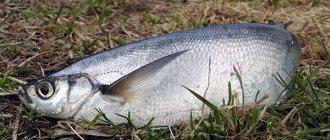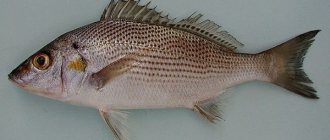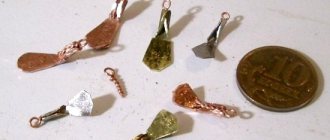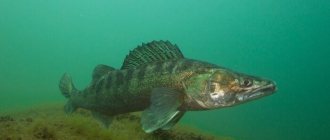Pike perch is a medium-sized fish from the perch family. With its elongated body shape it is similar to a pike, with transverse stripes on the sides it resembles a perch, it has two fangs on the lower and upper jaws, for which it received the nickname fanged from fishermen. Pike perch is one of the most popular fish among anglers who fish with spinning, trolling or live bait. Pike perch meat is considered dietary due to its high protein content and low fat content. A wide variety of dishes are prepared from pike perch, the most famous of which is pike perch aspic. Let's tell you more about this fish.
Appearance
Body of pike perch
Pike perch has a slender, slender, elongated body with slightly compressed sides, which is covered with small and hard scales that reliably protect the pike perch’s body from all kinds of injuries and the teeth of other predators.
The length of the pike perch's head is greater than or equal to the body height. The pike perch has an elongated, pointed, conical snout. The mouth is terminal and large.
The gill covers consist of three pairs: the operculum, the interoperculum and the preoperculum. This arrangement of gill covers provides pike perch with a reliable system for opening and closing gill slits.gill slits. approximately 20 elastic rays. A film with dark specks is stretched between the rays of the dorsal fin. When expanded, the dorsal fin of a pike perch resembles the dorsal fin of a perch, and is not inferior to it in terms of rigidity.
The caudal fin of the pike perch is symmetrical with powerful blades; the size and power of the caudal fin allow the pike perch to develop high speed.
On the lower part of the pike perch's body there are paired pectoral and ventral fins, and under the pike perch's tail there is an anal fin. All these fins have sharp spines that reliably protect the pike perch from enemies. The color of the fins is gray with a dirty yellowish tint.
Digestive system
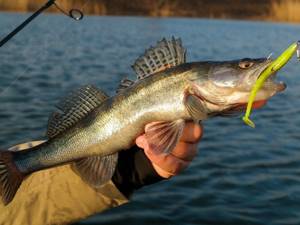
The entire digestive system of pike perch is designed for a predatory lifestyle. The pike perch swallows its prey whole. The pharynx, esophagus and stomach of pike perch are very strong, extensible and elastic. All organs of the pike perch are compactly located in the upper part of the body, closer to the head, while the abdominal region remains virtually free. When a pike perch swallows its prey, the stomach stretches, occupying the previously free space in the abdominal part of the body. Having swallowed the prey, the pike perch waits until it is completely digested, only after that it resumes its hunt.
Body coloring
The body color of pike perch living in different bodies of water varies significantly. Typically, pike perch has a grayish-olive body color, with 8-12 dark brown stripes on the sides and a grayish-white belly with a faint yellow tint. The gill covers and sides of pike perch may have a golden hue.
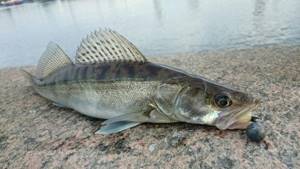
Pike perch are often found with light-colored scales of a straw-yellow hue, with very faint pale brown stripes that look more like spots than stripes.
In deep bodies of water, with cold water, a dark bottom and a lack of sunlight, pike perch of darker colors are found. The back of such pike perch is almost uniformly black, the sides are dark brown, on which dark stripes are barely visible.
Vision, sense organs
Vision is the main system of perception of the surrounding world for pike perch. The eyes of pike perch are large, round, convex, with a brown iris. The eyes of pike perch are adapted to perfectly see their surroundings at dusk and at night. In addition to the highly photosensitivity photoreceptor cells of the retina, the eyes of pike perch have a special vascular layer - the tapetum, which is located behind the retina and consists of flat cells filled with guanine, an organic substance that reflects light.
Rays of light passing through the retina are reflected from the tapetum cells, as if from a mirror, and again enter the retina, re-stimulating the photoreceptor cells of the retina.
This device for the pike perch’s vision increases its sensitivity, allowing the pike perch to see in low light conditions; in addition, thanks to the tapetum, the pike perch’s eyes glow in the dark. Thanks to its vision, pike perch sees well in the dark, but does not like bright sunlight and does not distinguish colors well.
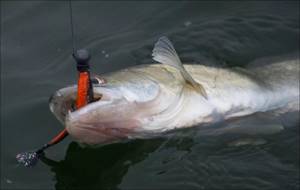
An important sensory organ for pike perch is the lateral line organ, which allows pike perch to catch the slightest vibrations in the water and accurately determine the distance and direction from the source of these vibrations. The lateral line begins in pike perch from the gill covers and runs throughout the body, right up to the tail; it is a canal with sensitive cells, which is connected to the outside world by small holes. The importance of the lateral line for pike perch is evidenced by the fact that a pike perch that has completely lost vision is able to survive by relying only on the information it receives from the lateral line.
Pike perch has a well-developed sense of smell. In the front of the head, under each of the eyes, the pike perch has two openings, these are the nostrils, from which there are passages to the internal organs of smell.
Pike perch has good hearing; it is able to clearly hear sounds heard on the shore of a reservoir, for example, human steps. Sound is transmitted through the bones of the skull to the right and left auditory sensors.
Pike perch, like other fish, has an organ of taste, the sensitive cells of which are located in the mouth of the pike perch, and organs of touch, the sensitive cells of which are located throughout the body of the fish.
Mouth, fangs and teeth of pike perch
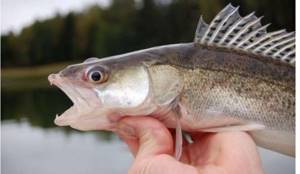
Pike perch has a large mouth; when open, it resembles a pike in its width and toothiness. There are two fangs on the upper and lower jaws of the pike perch. Of the perch family, only two species have fangs - pike perch and Chinese perch (auha).
The size of the fangs of a male pike perch is larger than that of a female, which is a distinctive sexual characteristic. Between and behind the fangs are small, sharp, conical teeth. The entire structure of the pike perch's maxillodental apparatus is designed to capture and hold prey.
Some physiological features
All of the above varieties have some common similarities in structure and appearance. When studying the question of what a pike perch looks like, you need to pay attention to the following features of its behavior and external signs:
- Fish belongs to the group of predators.
- The mouth contains sharp teeth with a special structure.
- The body is distinguished by an elongated shape and has transverse stripes with varying degrees of color (determined by the geographical features of the habitat).
- The lateral line continues on the tail.
- Males treat the future fry with special care.
Naturally, these are just some general signs characteristic of pike perch, because in fact there are many more of them. In addition, the varieties of fish have a lot of differences.
Very often, pike perch is given the name of an indicator of river cleanliness. It is known that it is able to lead a normal life only in unpolluted waters where there is a high oxygen content.
Fish also have one unique feature, which is the presence of two different forms of existence:
- residential,
- semi-through.
As already mentioned, representatives of the first form of existence are found only in fresh water, and semi-anadromous ones prefer estuary sea zones, and during the spawning period they quickly move to the lower reaches of rivers.
Marine variety
Representatives of the marine species, scientifically called Sander marinus, are found in the coastal regions of the Black Sea and in the waters of the Caspian Sea.
In Ukraine, sea pike perch is listed in the Red Book and is considered extremely rare. The external characteristics of the species are not much different from those characteristic of freshwater inhabitants.
Key characteristics include:
- The body is elongated and slightly flat at the side, reaching 50 centimeters in length. Less commonly, adults grow up to 62 centimeters, gaining up to two kilograms of mass.
- Both jaws have sharp fang teeth.
- On the back there are two fins, which are placed one behind the other. Moreover, in the first there are 12 hard rays, and in the second there are only 2 hard ones, and the rest are soft.
- Representatives of the species have a light gray body color with dark transverse stripes, which are located on the sides in the amount of 12-13 pieces.
- The diet of sea pike perch includes any small fish.
- Sexual maturity and readiness to reproduce begins at the age of 2−5 years. Egg spawning occurs between April and May. A fertile female is capable of laying up to 100 thousand eggs on rocky soil.
- Marine species are found within their own body of water and practically never leave it.
Fish that are found in the Caspian and Black Seas differ from each other by different dorsal fins . The fins of the former are separated by a small gap, while the fins of the latter are connected to each other and touch.
In addition to the mentioned external characteristics, marine species also have smaller eyes and fewer rays in the anal fin. By comparison, freshwater species have more of them.
Freshwater (common) species
Representatives of this species are found in freshwater bodies of Eastern Europe, Asia and Russia. They can also be caught in the rivers of the basins of large seas, including the Azov, Black and Baltic.
The distinctive features of the common pike perch are as follows:
- An adult grows up to 60-70 centimeters in length.
- The fish gains up to four kilograms of weight, although some individuals can grow up to 15 kg.
- The fangs are found on both jaws and are quite large in size. In females they are slightly smaller and shorter than in males.
- Common pike perch have two successively placed dorsal fins with soft and hard rays. There are from 19 to 24 soft rays in the second dorsal fin.
- The fish is colored greenish-gray on the back and has a light color on the belly. In the side part there are 8-12 transverse stripes of a dark brown color.
- Juveniles prefer all kinds of insects and aquatic invertebrates. Older pike perch begin to feed on small fish.
- Puberty ends at the age of three to four, and egg laying occurs in the spring, provided that the water temperature is at least 12 degrees Celsius. After entering shallow water areas, females lay up to 1 million eggs on various substrates. In turn, the males carefully clean the spawning site, keeping it clean until the fry appear.
- Representatives of the residential form of existence live in freshwater rivers, and their close semi-anadromous relatives are found in sea water, returning back to rivers to spawn.
Due to the characteristic features of the structure of the mouth and narrow pharynx, the fish is not able to eat large prey. Therefore, the diet is based on small fish : bleak, sprat, minnows and gobies.
The duration of the egg development process depends on temperature indicators. If the water warms up to 18 degrees Celsius, then 5-6 days are enough for the eggs to turn into fry, but if the temperature rises to 20 degrees Celsius, then this process takes up to 3-4 days.
Representatives of the ordinary variety also have excellent vision , which helps them examine objects even in the dark. The fish's visual apparatus contains a reflective layer, which helps the eyes glow in the dark.
Age and size of pike perch
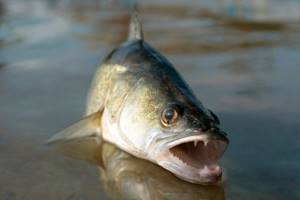
Pike perch is the largest fish in the perch family. In favorable conditions, pike perch can grow up to 140 cm in length, reaching a weight of 15-18 kg. The maximum lifespan of pike perch is 14-15 years. But fish of this size are extremely rare; pike perch weighing 4 kg or more is already considered a very good trophy.
You might be interested in: Chinook salmon
Nutritional value and benefits of pike perch
The excellent nutritional value of pike perch is due to the wide range of nutrients contained in the meat. Meat products contain about 20 amino acids, including the most essential substances for the human body.
Pike perch meat is considered a real record holder for the content of protein, amino acids and cobalt . As for the beneficial properties, they directly depend on the nutritional composition.
It is no secret that the basis of protein molecules (the main building material for all tissues of the human body) are individual amino acids. They are present in large quantities in pike perch meat, so regular consumption of such fish products helps improve immunity and the effective production of hormones and digestive enzymes.
These substances are essential for various diseases and circumstances, including:
- Severe physical, mental or emotional stress.
- After complex illnesses (as a preventive, therapeutic and restorative agent).
- During the period of active growth of the child’s body.
- During pregnancy and breastfeeding.
Many athletes consume pike perch meat, which is rich in protein , to build muscle mass. In turn, it helps overweight people lose excess weight and restore body elasticity.
In terms of the amount of cobalt, pike perch is considered a food leader. But this element has a positive effect on the processes of hematopoiesis, the breakdown of carbohydrates, proteins and fats, as well as on the synthesis of amino acids. It also absorbs iron and changes hemoglobin levels for the better . Cobalt is indispensable for the following problems:
- Anemia and anemia.
- In case of metabolic disorders.
- For diseases of the gastrointestinal tract.
- Increased nervous excitability.
- Chronic fatigue.
- When the functions of the immune system deteriorate.
- For diseases of the thyroid gland.
The rich content of fluorine and phosphorus has a positive effect on the condition of teeth . Together, these elements regulate neuromuscular activity, strengthen the walls of blood vessels and lower cholesterol levels, effectively preventing the development of heart disease.
Relatives of zander
The marine form of walleye, the ancestor of modern walleye, arose during the Oligocene period, 34 to 24 million years ago.
The first freshwater pike perch appeared in Siberia during the Pliocene era, from 5.3 to 3 million years ago. Fossils found by scientists indicate that over the past 3 million years, pike perch has practically not changed its appearance compared to its ancestral form.

Pike perch is part of the perch family, which also includes such well-known fish as perch and ruffe. In the perch family, pike perch is included in the separate genus Sudaki.
The genus Sudaki includes 5 biological species:
- The common pike perch is the most widespread and best known species. The scientific Latin name for this species is Sander lucioperca.
- Light-finned (yellow) pike perch - got its name for the light color of its fins. The scientific Latin name for this species is Sander vitreus.
- The Canadian walleye is a North American species of walleye found in the St. Lawrence River, its tributaries and lakes included in this river system. The scientific Latin name for this species is Sander canadensis.
- Sea pike perch is the only species among pike perch that constantly lives in salty sea water, and not in freshwater bodies. Lives in the Caspian Sea and coastal areas of the western part of the Black Sea, does not enter fresh waters. Sea pike perch is a relatively small fish, reaching a maximum length of 50 cm and a maximum weight of 2 kg. The scientific Latin name for this species is Sander marinus.
- The Volga pike perch (bersh) is a smaller copy of the common pike perch, reaching a maximum length of 45-50 cm and a maximum weight of 2-2.5 kg. Found in rivers of the Black, Caspian and Azov seas. In appearance it is very similar to the common pike perch, but unlike it, it has darker and more clearly defined stripes, the bersh has no fangs, the bersh's head is shorter and wider, and the bersh has larger scales. The scientific Latin name of this species is Sander olgensis.
Origin of the species and description

Photo: Sudak
Pike perch belongs to the chordates, divided into the class ray-finned fish, the order Perciformes, the perch family, the genus pike perch, and the species common pike perch. Fans of fish dishes prepared with pike perch do not assume that they are eating one of the most ancient representatives of flora and fauna living on earth. Surprisingly, scientists believe that the ancient ancestors of pike perch appeared about 25 million years ago. Over the last 4-5 million years of their existence, they have not changed at all in appearance.
Video: Sudak
The ancient ancestors of modern pike perch were fish that lived in the depths of the sea. The period of their appearance is called the Oligocene period, 33-23 million years ago. Numerous DNA examinations of the discovered remains revealed that modern pike perch appeared during the Pliocene period, approximately 5.5 million years ago. Siberia is considered the birthplace of modern fish.
Numerous studies have made it possible to determine that centuries-old evolution has had virtually no effect on the appearance of this fish. However, in the process of evolution, this species of freshwater representatives of the perch family has significantly expanded its habitat region. From Siberia, pike perch has spread almost throughout the world. There are several types of pike perch. Three species live on the territory of the Russian Federation: common, Volga and marine.
Spreading
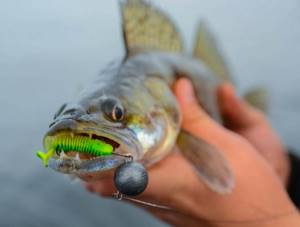
Pike perch is common in medium and large rivers of Eurasia. Pike perch is found in the rivers of the Black, Caspian, Azov, and Baltic seas. In Western Europe, pike perch can be found in all major European rivers. North of 64 degrees north latitude, pike perch are rare. Most pike perch are found in large rivers: the Volga, Ural, Don, Oka. Pike perch are often found in lakes and large reservoirs.
River fish pike perch
Most often, this name refers to the species “common pike perch.” It lives everywhere in rivers and large freshwater bodies of eastern Europe, as well as in adjacent regions of Asia. We are talking about the basins of the Baltic, Black, Azov and Caspian seas, lakes Issyk-Kul and Balkhash, as well as what was once called the Aral Sea. In addition, populations of common pike perch are found in desalinated areas in the river deltas of these seas.
Pike perch is a fairly large fish; by the time of puberty (in the fourth year of life) it reaches a weight of 600 to 1000 g. Moreover, growth does not stop there and upon reaching the full four years it already weighs on average about 1.4 kg, at five years - 2.4 kg. Officially recorded cases of catching individuals weighing up to 15 kg, although this is probably not the limit.
Pike perch has an elongated long body, which reaches 40 cm at the age of three years. The fish is covered with gray-green scales with a lighter belly and a dark back. In the central part of the body there are dark spots, which sometimes form quite clear vertical stripes. Being an aggressive predator, pike perch is endowed with a set of powerful fang-like teeth, almost like those of a dog or cat. At the same time, a male can be easily distinguished from a female by its significantly larger fangs.
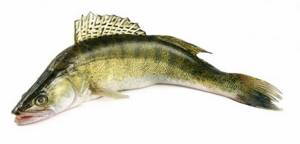
The diet is based on smaller fish, mainly gobies, gudgeons, bleak and sprat. The reservoirs where pike-perch fish live are certainly clean and rich in oxygen. It cannot be found in muddy and swampy waters.
The second freshwater species of pike perch common in Russia is the Volga pike perch, also known as bersh or bersh. Visually, it is quite similar to an ordinary pike perch, but is smaller in size (usually no more than 45 cm and 3 kg). Also, the bersh is practically devoid of massive fangs, although it is also a predator. In addition to the Volga, this fish lives in other rivers of the Caspian, as well as the Azov and Black Seas. Cases of its exit into the Caspian Sea have been noted.
Pike perch habitats
Pike perch loves large expanses of water and is very demanding about the purity and amount of oxygen in the water, therefore it avoids reservoirs with stagnant water where there is no current. The main condition for the existence of pike perch in a reservoir is the presence of clean running water; in those reservoirs where there is no running water and there are no springs or springs flowing into the reservoir, there will be no pike perch.
Pike perch prefers to live in large and deep rivers, choosing places with a rocky, gristly or sandy bottom. In rivers, pike perch prefers to stick to deep places: holes, whirlpools, steep yars. Pike perch likes to stay in places where the depth changes sharply, on the so-called depth drops, on channel and near edges. Pike perch likes to stay in snags, among fallen trees and bushes.
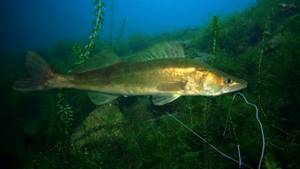
Small pike perch often stand in shallow places. To hunt, pike perch go out to shallow sections of the river, sand spits, in the evening and in the morning, where they hunt for small fish.
Pike perch can live not only in rivers, but also in large and deep lakes and reservoirs with running water. Here it also sticks to the deepest places, areas of the flooded river bed, former ravines, deep holes and areas littered with snags.
In both rivers and reservoirs, pike perch likes to hide in unnatural shelters formed at the bottom of the reservoir; these can be sunken boats, reinforced concrete piles, collapsed bridge structures or railroad sleepers.
Where pike perch live and are caught
Large perch do not tolerate oxygen deficiency in water and high levels of suspended matter, pollutants, and methane. That is why they prefer flowing, clean reservoirs with a hard bottom and an abundance of springs and springs. Rare exceptions can be considered ruffes and perches, which are less demanding on the environment due to their small size and often successfully live and spawn in ordinary ponds, where there are a lot of small carp fish.
Pike perch are caught in deep lakes and rivers with moderate to fast currents throughout central Russia, including:
- northern regions (Novgorod, Leningrad, Pskov regions);
- the south of the Black Earth Region (Tambov, Voronezh, Rostov, Belgorod, Kursk, Lipetsk);
- eastern Volga region (Saratov, Samara, Kirov, Mordovia, Ulyanovsk, Penza).
To learn more:
What is bleak and where does it live?
The predator is resistant to low temperatures, so it can be found at the very edge of the northwestern border of the European part of the country. It is found in the Neva, Ladoga, Sumozero, Yanisyarvi, Ohtanyarvi, Sandal. In addition to the Baltic basin, the fish forms numerous populations in rivers and tributaries that supply water to the Black and Caspian Seas. In the east, the range is limited by the Ural River. In addition, pike perch lives in reservoirs, for example Rybinsk, Saratov, Krasnodar, Ivankovsky, Sheksninsky.
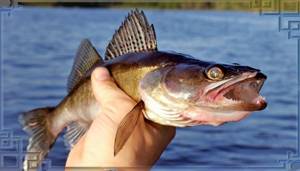
In the sea, it is best to look for a predator in the central and southern parts of the Caspian Sea, in the north-west of the Black Sea coast, in the area of the Crimea Peninsula, near the Dnieper delta and the Southern Bug. Sea pike perch prefers a sedentary lifestyle at moderate depths of 25-40 meters with a clean bottom (stone, pebbles, sand). It is quite problematic to independently detect concentrations of predators. Tips from local fishermen will help out.
How to find pike perch on the river
Perches love fresh water with a slight current, so they often settle in holes, piles of stones and snags near a riverbed, riffle, edge or ridge. Shallow water (1-1.5 meters) and coastal thickets are almost never promising fishing grounds. The cautious predator comes here only in the early morning or late evening.
That is why you need to look for pike perch on the river in open water and at significant depths (from 3-5 meters). In summer, cool bottom layers deserve special attention. In autumn and spring - average, which have time to warm up a little in the sun.
If a pike bite occurs, it is better to change the place, since these two species try to avoid each other due to fierce food competition.
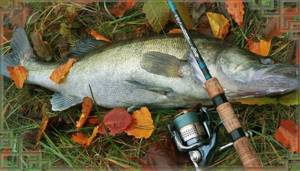
Sedentary and semi-anadromous pike perch
The common pike perch is a freshwater fish, but exists in two forms: residential-river-sedentary and sea-semi-anadromous.
The resident form of pike perch spends its entire life in the river, and this is where it reproduces.

The marine semi-anadromous form of pike perch spends the main part of its life in the sea, most often in the slightly salty part of the Azov or Caspian Seas. Here pike perch feed on sprat, gobies and sabrefish. Due to the abundance and variety of prey caught by pike perch in the sea, semi-anadromous pike perch grow faster and are usually much larger than sedentary pike perch. At the time of spawning, in March-April, semi-anadromous pike perch enters the rivers and rises upstream. Most often, semi-anadromous pike perch spawn at a short distance from the sea. After the end of spawning, in April-May, semi-anadromous pike perch returns to the lower reaches of the river, to desalinated areas of the seas.
Population and species status
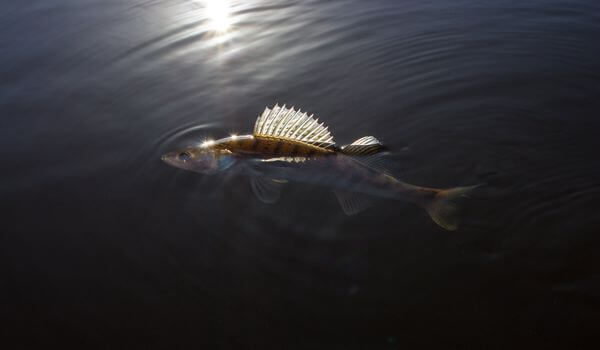
Photo: Pike perch in the lake
Researchers have identified several populations. One of them is the sedentary pike perch, which lives mainly in one territory. It tends to leave its usual habitats only in case of water pollution. In this case, the fish travels far, many tens and sometimes hundreds of kilometers.
Another population of predators is the migratory pike perch. It lives in reservoirs, estuaries and other freshwater bodies. With the onset of spring, this population of predators moves upstream to spawn. Migration can occur over several tens or even hundreds of kilometers. Afterwards it returns again to its usual and favorite places.
Today, the number of fish in some regions is rapidly declining. We are talking mainly about marine species of pike perch. The reasons for the decline in its numbers are water pollution, poaching on a particularly large scale, as well as a sharp change in climatic conditions in some regions. The presence of fish of this type indicates the true natural purity of the reservoir.
Zander lifestyle
Pike perch prefers to lead a gregarious lifestyle. Small pike perch live in large schools. Pike-perch weighing 800-900 grams live in schools of 10-30 fish. Larger pike perch stay in even smaller schools. The rule almost always applies: the larger the pike perch, the smaller the school. The largest pike perch stay and hunt alone.
In late autumn, pike perch migrate to great depths of up to 10-12 meters for wintering, gathering in large schools for this purpose. The time for pike perch to gather in large schools coincides with the yellowing of birch leaves. At the head of the school are the largest individuals, and the school is closed by the smallest pike perch, wintering for the first time. Winter stops for pike perch are the deepest parts of the reservoir. The school stays together until spawning, then breaks up into separate schools and groups.
You might be interested in: Jig
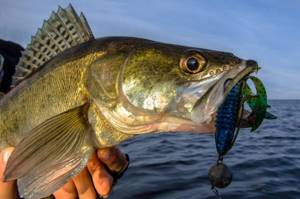
Pike perch is most active in the evening and at night, preferring to stay in deep places in the reservoir during the day. During the daytime, pike perch is mainly at rest.
Pike perch and pike often coexist in the same body of water, while rarely intersecting with each other. Pike hunts during daylight hours, most often at mid-water or near the surface, while pike perch hunts mainly at night and most often near the bottom.
When and where to catch pike perch
Walleye habitat
Pike perch is thermophilic, loves open spaces and is very demanding on the composition of oxygen in water, therefore it avoids reservoirs with stagnant water where there is no current. It prefers large and full-flowing rivers, choosing places in them with a rocky or sandy bottom, digging a shallow hole in hard ground or hiding under a stone, it can stand under the very stream of a well-oxygenated watercourse.
It adheres to deep places: on slopes in the main - deep channel or in front of them - on the upper edges. It loves a rocky, hard bottom, littered with fallen trees and bushes. Pike perch also live in large, fairly deep natural lakes and reservoirs with running water.
Slowly flowing rivers with silted soil, ponds, artificial lakes - such a habitat is not suitable for our hero. This fish does not live in low-flowing and stagnant water; it dies from anoxia.
Lifestyle and habits of pike perch
Our character leads a schooling lifestyle, juveniles gather in large herds, while larger individuals from 800-900 g keep in groups of 10-30 fish. In late autumn, all S. roll down to great depths of 10-12 m, remaining there to winter. Before this, gathering in large schools, organized by age. The leading ones - the largest individuals - are located at the head of the echelon; the squadron is closed by the juveniles, wintering for the first time. Knowing this feature, you can find trophy specimens while ice fishing by determining which way the herd is facing. After wintering, the school stays together until spawning, and then breaks up into schools and groups.
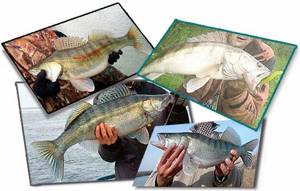
Our predatory character spawns early, as soon as the water warms up to 8-10˚C, it won’t keep you waiting. In the southern regions of Russia this happens in the first ten days of April, in European territories with a mild climate - by the end of April, in regions located closer to the north - in the second half of May or early June.
During the spring flood, while pike perch, hungry over the winter, are still holding together in a single school, this pre-spawning period is considered the most favorable for fishermen.
Being a nocturnal predator, the spiny fish-eater is most active in the evening and at night. During the day, an animal experiencing photophobia is forced to hide in deep and shaded areas of the reservoir from the penetrating rays of the sun, hide in shelters and take cover under various objects.
Unlike other fish, pike perch does not have the habit of splashing, jumping out of the water, which, combined with its twilight lifestyle, makes its stay in a body of water so unnoticeable that many fishermen are surprised when they catch it. On cloudy spring and autumn days, the fanged robber can be caught during the daytime, but not as fruitfully as in the evening and at night.
Predator parking and feeding areas.
Traditional pike perch anchorages at any time of the year are considered to be areas of the bottom in places where there is a difference in depth: the upper edges near the drop-offs into the main channel, and the drop-offs themselves into the fairway. At a great depth of 8-10 m, pike perch are caught more often and larger. In shallow waters, trophy specimens 70-80 cm or more are not worth looking for; they come out there only once a year or every other time - during spawning. Having spawned, the fish remains to guard it, but catching pike perch at this time is prohibited and unsportsmanlike.
In the daytime, the boat can be found in shaded places, under bushes or trees hanging from a cliff. The handsome striped fish is very fond of strong rubble, thick tree crowns that have fallen into the water - old and without foliage, around which it can only be fished with special live bait tackle - a baitfish. A group of 7-15 fish weighing 1.5-2.0 kg each can hide under a large log lying on hard ground. If you carefully catch this walleye bastion using a spinning rod, you can get a good result. Carrion fishermen use spinning non-snagging baits on offset hooks.
This must be done in such a way as not to scare away the friends remaining under the snag, landing the fish quickly and quietly, and besides, it does not resist. Compliance during fishing is a characteristic feature of pike perch. We must keep in mind that frightened predators very soon return to their place.
When searching for pike perch places, you should pay attention to unnatural shelters, which are sunken boats, reinforced concrete piles, collapsed bridge structures, railroad sleepers and other traces of human activity.
The ancient native of Siberia does not like and avoids the muddy bottom, which does not allow him to dig holes in it and lie on its loose surface, raising columns of turbidity at the slightest movement.
What does pike perch eat?
Pike perch is a typical predator. The newly hatched pike perch larva feeds on zooplankton: diaptomus and cyclops, insect larvae and bottom invertebrates.
Having reached a size of 20-30 mm, pike perch begins to feed on larvae and the smallest fry of other fish.
Pike perch that have grown to 500 grams feed mainly on small fish. Adult pike perch of any size, up to trophy specimens, prefer to feed on small, narrow-shaped fish, 8-9 cm long. Pike perch mainly feed on: bleak, minnows, gobies, small roach, and sprat.
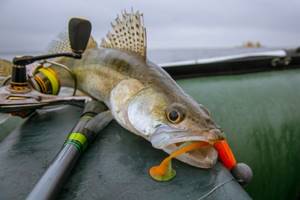
Residential and semi-anadromous forms of pike perch have the same diet, but pike perch living at the confluence of rivers into the sea have a greater choice of food and their prey is usually larger, so semi-anadromous pike perch grow much faster.
After the pike perch has caught and swallowed its prey, it stands in a shelter, near a stone or snag and waits until the prey it has swallowed is digested, only after which it resumes its hunt. The pike perch is very careful in swallowing its prey, because prey that is not sized or swallowed incorrectly can get stuck in its narrow throat.
An adult pike perch is more voracious than even pike and perch; in favorable conditions it can grow in 2 years to a weight of 1 kg. To increase weight by 1 kg, pike perch must eat about 3.3 kg of fish.
Nutrition
The newly born larval pike perch feeds on zooplankton, all kinds of diaptomus, and cyclops. As it grows, it moves onto the larvae of insects, other fish, and bottom invertebrates. Then tadpoles and small fish are included in the diet.
Residential and semi-anadromous forms have a similar diet. But pike perch living in areas where rivers meet seas have a wider choice. The prey they encounter is larger, so they grow faster. In addition, they need additional fat to travel to places where pike perch .
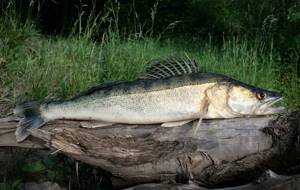
When obtaining food, pike perch exhibits a peculiarity associated with the structure of its internal organs. After swallowing more or less large prey, the pike perch stands in a shelter near a stone or snag and waits for the digestion of the caught fish to finish. After which he returns to his hunting grounds.
How to hunt pike perch
Pike perch is a typical predator; its diet consists of small fish of various species. Pike perch uses two different methods in hunting prey: from ambush and from hijacking.
When hunting from an ambush, the pike perch takes cover behind some uneven bottom, snag or stone lying on the bottom, waiting for its prey until it is within throwing distance of it.
When hunting for stealth, pike perch patrols its grounds, moving along edges and steep slopes into the depths, from one shelter to another. As soon as the pike perch encounters prey on its way, it quickly attacks it with a swift throw.
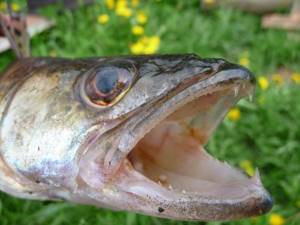
Chasing a bleak or some other fish, the pike perch, in the excitement of the chase, jumps out onto a shallow place or even onto a sandy shore. After floundering, the pike perch rolls back into the water, but it happens that it doesn’t succeed and then it either falls into the hands of a person or simply dies on the shore.
At night, pike perch go to shallow waters to hunt, organizing a so-called “fight”, with characteristic pike-perch splashes. The pike-perch “fight” differs from the “fight” of other predatory fish. The pike-perch “fight” begins as if on command, the pike perch begin to chase the bleak across the entire surface of the river or lake, the pike-perch “fight” usually lasts 20-30 minutes. The sound of a pike perch splash during a “fight” is similar to the sound of a stone thrown into the water. During the “fight,” the pike perch does not take any bait, but as soon as the fight ends, the pike perch begins to be caught.
How to choose?
To purchase high-quality fresh fish, you need to pay attention to:
- smell (a pleasant fishy smell should emanate from the carcass, not too strong, without foreign aromas);
- eyes (they should retain a shine; a cloudy look indicates improper storage);
- appearance and elasticity (the carcass should be elastic and smooth to the touch, without traces of dirt, blood stains or strange tubercles);
- gill color (it should be pinkish or reddish, but not dark).
When buying a frozen pike perch carcass, you should pay attention to the following:
- the fillet should be white, without any tints;
- there should not be a lot of ice on the fish;
- the smell should be similar to fresh fish;
- the carcass must be clean, without blood or irregularities;
- After defrosting there should be no foreign smell.
When purchasing smoked pike perch, you need to pay attention to the smell of the fish (it should be pleasant, with light notes of wood smoke) and color (the carcass should be evenly golden).

Reproduction
Pike perch reaches sexual maturity and begins to participate in spawning at the age of 4-5 years. Females mature a little earlier, males a little later. Pike perch living in northern, colder conditions mature 1.5-2 years later.
Pike perch spawn in the spring, when the water warms up to 8-10˚C. In the southern regions of Russia this happens in early April, in the reservoirs of the European part of Russia at the end of April, in the northern regions of the country in the second half of May and even early June.
For spawning, pike perch most often chooses shallow water areas that warm up well, usually sandbanks and rocky ridges. Often in such places there are flooded bushes, trees, and large debris at the bottom. The depth at the spawning site can be from half a meter to six meters.
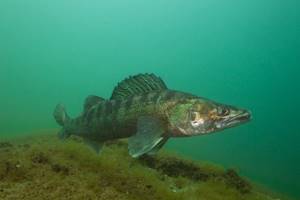
During spawning, the male pike perch makes a nest on the bottom, using his abdomen and fins to clear the site of future egg laying from silt. Then the female approaches the nest, she lowers her head and raises her tail, assuming an almost vertical position and releases eggs. The female stimulates the release of eggs with swinging movements of her tail. The male circles around the female and releases milk. The eggs, falling into the nest, have time to be fertilized.
Pike perch caviar has an egg diameter of about 1-1.5 mm, it has a yellowish tint. One female, depending on her size, lays from 100 to 300 thousand eggs. The shell of the eggs is sticky, so they are reliably glued together and firmly held in the nest.
The male pike perch, unlike the female, remains at the nest and protects its future offspring. With its fins, it increases the circulation of water around the laid eggs, thereby ensuring oxygen access to each egg. If the male guarding the nest dies, another male takes his place and guards the nest instead of the deceased. The male pike perch guarding the nest is very aggressive in meeting other fish, including pike perch, trying to approach the nest. Having spread his fins and protruded his gill covers, the male pike perch rushes at the enemy. The male pike perch guards the nest for 1.5-2 weeks, until pike perch larvae emerge from the laid eggs.
The larvae and fry of pike perch grow very quickly, at the age of 1.5 months they already reach a length of 7-8 cm, and by autumn they are 14-17 cm long.
Reproduction and lifespan
Throughout its range, pike perch begins to prepare for procreation in February–April. Semi-migratory pike perch enters the river delta. It can spawn from the lower reaches of the delta to places located several kilometers upstream.
Spawning in the delta of the Volga and Ural lasts 2-3 weeks, from mid-April to May 5-10. In the warmer Kura, pike perch spawn for the same 2-3 weeks, but the action starts at the end of February.
For spawning, tributaries, lakes, overflowing river branches, and reservoirs with weak currents are selected. Female pike perch lay their eggs at a short distance from the shore. Any underwater objects are suitable as a base for laying out the caviar mass: driftwood, roots, stones.
The spawning process is unusual. Before spawning, the male cleans the intended laying site. After which a pair is created. The male brings the chosen one to a site suitable for spawning. The female lowers her head, raises her tail, and finds herself in an almost vertical position.
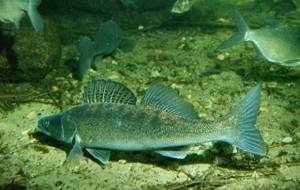
The process of releasing eggs begins. At the same time, the female does not make sudden movements. The release of eggs is stimulated by swinging turns of the tail. Mahalki, as fishermen call them, are visible above the water surface. They are observed in large numbers in pike perch spawning areas.
The male pike perch walks around the female and releases milk. The eggs of the pike perch fall towards the nest. Before the eggs combine into a common mass, they have a high chance of being fertilized. Each fish egg does not exceed 1-1.5 mm in diameter. A female can give birth to from 100 to 300 thousand future pike perch.
The shell of the eggs is sticky, so the entire volume of eggs is firmly held in the “nest”. After laying eggs, the male protects the future offspring - a cluster of eggs. He drives away numerous people who want to eat future pike perch. In addition, by acting with fins, it creates a water flow around the masonry, providing access to oxygen for the eggs. The pike perch stands above the “nest” until the larvae appear.
The female pike perch, having spawned, leaves for its permanent habitat. Semi-migratory pike perch are sliding towards the sea. Residential forms move to cleaner, deeper places in rivers, reservoirs, and lakes. 1.5-2 weeks after the birth of the offspring, the male pike perch follows the same path as the female.
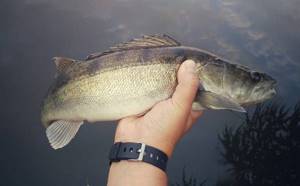
Fishing for pike perch
Pike perch is both a valuable commercial fish and a favorite object of many anglers for recreational and sport fishing.
You may be interested in: How to tie a leash to the main fishing line
Pike perch are caught all year round. One of the best seasons for catching pike perch is winter. In winter, pike perch are caught using spoons and balancers. Many anglers catch pike perch in winter using sprat. For this purpose, sprat is purchased in advance and stored in the refrigerator before fishing. To catch the sprat, put it on a large jig. This method of fishing can be very catchy. Pike-perch is inactive in winter, so for successful winter fishing for pike-perch, an angler must know well the body of water where fishing is carried out, and know exactly the places where it can stand: holes, deep slopes, edges, snags. In winter, pike perch especially likes to stand on edges with a sharp change in depth.
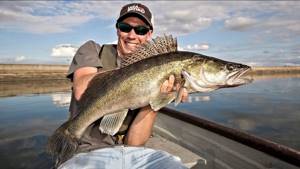
With the arrival of spring, the spawning rush begins; at this time, pike perch gains weight before spawning. During the pre-spawning period, you can successfully catch pike perch using spinning rods, jig baits or tight sprat. During the spawning period and for some time after it, pike perch cannot be caught, and a little later the post-spawning feast begins. In general, spring is a difficult time for catching pike perch; the angler constantly has to look for pike perch sites and select working baits.
With the beginning of the warm season comes the most popular time for catching pike perch among anglers. At this time, pike perch are caught using spinning, trolling, live bait bottom tackle and side fishing rods.
Spinning is one of the most popular methods of catching pike perch, since pike perch fishing is most often carried out at decent depths, at a distance from the shore; when catching pike perch with a spinning rod, it is advisable to use a boat. Some anglers fish for walleye from piers, embankments, bridges or steep drop-offs, but many times it is better to fish for walleye from a boat. When catching pike perch with a spinning rod, a variety of spinning baits are used: rotating and oscillating spoons, wobblers, but the best way to catch pike perch is with jig baits. When catching pike perch with a spinning rod, you need to make a strong, energetic hook so that the hook of the bait can pierce the hard palate of the pike perch.
Catching pike perch by trolling has become increasingly popular among fishermen in our country in recent years. Trolling can be called a modernized ancient method of catching pike perch on the track. Trolling for pike perch is effective from spring to autumn. Both spoons and wobblers can be used as bait when fishing for pike perch. Wobblers are especially effective. The basis for successful trolling for pike perch is the correct choice of bait and the depth at which fishing is carried out.
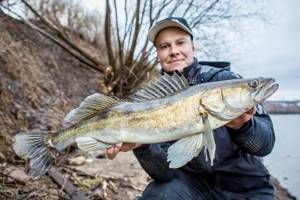
A very popular way of catching pike perch is fishing with bottom live bait. With such gear you can catch pike perch throughout the open water season, from the beginning of spring to the end of September, that is, until the pike perch goes to greater depths for the winter. For fishing, use a regular donkey with a load of 100-150 grams. Live bait is placed on the hook and does not fall asleep on the hook for a long time; minnows, roaches, bleak, and crucian carp are well suited for this purpose. The optimal length of live bait is 6-8 cm.
Some anglers catch pike perch from a boat using an onboard fishing rod, baiting the hook with exactly the same bait fish. When fishing for pike perch on a side fishing rod, you can slowly raise the bait with a step and sharply lower it to the bottom. Live bait can be attached to a jig or jig head.
No matter how an angler catches pike perch, it is best to catch it twice a day. The best time for catching pike perch begins at dawn and continues until full sunrise. During the day, pike perch are caught much worse. Good fishing for pike perch resumes in the evening dawn and continues until about 12 o'clock at night. It is in the morning and evening hours that pike perch approach shallow waters, closer to the shore, as well as rocky ridges, pebble and sandbanks, while moving along steep slopes in the depths and edges of the flooded riverbed.
Autumn is rightfully considered the best and most catchy time for catching pike perch. In the fall, pike perch can be caught using all the methods available to anglers: spinning, trolling, bottom or side fishing rods equipped with live bait or dead fish. For successful fishing, an angler must know well the places where pike perch camp, and constantly experiment with baits and methods of placing them.
Lures for zander
In spring, pike perch fishing is very good using jigs. Use a simple hook (single or double), but if the bottom is cluttered with snags, bushes and there is a high probability of getting a snag, it is recommended to fish with an offset hook. Twisters and vibrating tails are actively used. It is worth remembering that in the spring, fish in most cases bite before sunset, and not in all places in the reservoir.

Summer is the best time for pike perch fishing for beginners. The fish is extremely active. It will be difficult to catch it during the day due to the high temperature. At this time, it lies at the bottom - in places where it is coldest. But in the evening, from sunset until dawn, the predator swims out to hunt. To lure pike perch, it is recommended to use small wobblers.
In autumn, the water temperature begins to drop noticeably. During this period, the pike perch already feels good and does not hide under snags during the day in search of coolness. Daytime pike perch fishing is quite successful and always brings positive results. Most often, the predator can be found on rifts, under bridge supports, in ditches and in dry bushes. When fishing, jig baits, twisters, spinners and vibrotails perform well. In winter fishing for pike perch, two methods are used:
- the use of girders - simple equipment with bait bait;
- vertical fishing for pike perch in winter using a balancer (works great in the spectrum from yellow to red colors and their various shades).
Instead of live bait and various artificial baits, you can use and attach worms, leeches, and frogs. Pike perch bites well on them too.
{banner_vnutri-kontenta-3}
In cooking
Pike perch meat is considered a valuable dietary product due to its high protein content (18.4 grams of protein per 100 grams of product) and low fat content (1.1 grams of fat per 100 grams of product). The protein content in pike perch meat exceeds 18%; it contains all 20 amino acids, 8 of which are essential, that is, not synthesized in the human body. In addition, pike perch meat contains a wide variety of mineral elements necessary for the normal functioning of the human body. Pike perch meat is especially rich in phosphorus, potassium, iodine, molybdenum and manganese.

The calorie content of pike perch meat is 84 kcal per 100 grams.
In domestic fish stores, pike perch is offered in uncut frozen form, or in the form of ready-made pike perch fillet. Whole pike perch costs a little less, pike perch fillet costs a little more. Based on prices in fish stores, pike perch can be classified as an average-priced fish.
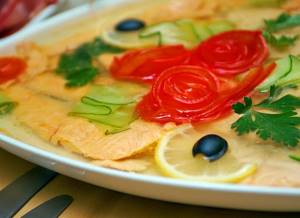
Pike perch can be prepared in all possible ways: boil fish soup from it, fry it, bake it, smoke it, and even dry it. A special dish that is prepared specifically from pike perch is aspic. Jellied pike perch is a wonderful dish that can decorate any holiday table.
Useful properties of fish
Due to its minimal fat content, pike perch is excellent for people who are concerned about their weight, as a dietary food, for postoperative patients and for various diseases, as well as for young children accustomed to eating regular food.
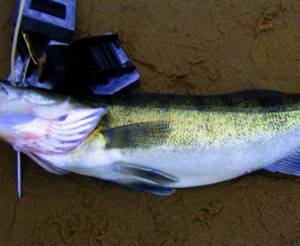
Sea or river fish pike perch is a storehouse of vitamins and nutrients. The sulfur contained in fish is useful when consuming other foods, helping them to be fully absorbed. Due to it, bone and muscle tissues, nerve cells, skin, nails and hair are rehabilitated.
Chromium helps the body get rid of toxic substances and helps stabilize blood sugar levels. Potassium prevents tissue swelling, promptly rids the body of excess fluid, and increases a person’s endurance.
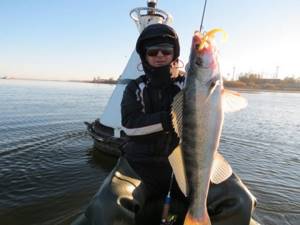
Fluorine and phosphorus ensure normal functioning of blood vessels, heart and nervous system. In addition, the contained vitamin PP helps eliminate toxins, reduces cholesterol, has a calming effect on the nervous system and stabilizes brain function.

General information: species, distinctive features, habitat

According to the existing taxonomic classification, belonging to the family of perch and the genus of ray-finned fish, pike perch combines several species:
- ordinary;
- Volzhsky (bersh);
- nautical;
- light-feathered (yellow);
- Canadian (sandy).
Moreover, the latter two live mainly in the waters of North America. In the reservoirs of Russia there are bersh and common pike perch. And the marine one lives in the waters of the Caspian Sea and the northwestern region of the Black Sea.
The above species have much in common with each other, especially with regard to structure and external features.
Among the main ones we can note:
- predatory lifestyle;
- the presence and special structure of teeth in the oral cavity;
- an elongated body with transverse stripes that have varying degrees of color depending on the habitat;
- continuation of the lateral line on the tail;
- caring attitude of males towards future fry.
Of course, these are not all the signs that are similar for pike perch species. Along with them, there are also significant differences that are inherent to one or another individual.
Pike perch is often called an indicator of river cleanliness. Because it can normally exist and develop only in unpolluted water bodies with a high oxygen content in the water.
Another distinctive feature of this genus of fish is the presence of two biological forms of existence:
- residential;
- semi-through.
Residential fish are characterized by permanent residence in freshwater rivers. Semi-anadromous individuals are characterized by a certain intermediate position: they live most of the time in the estuarine areas of the seas, and for spawning they move to the lower reaches of rivers.
Next, we will consider in detail each type of these aquatic representatives.
Pike perch - Features and habits
This is a large fish of commercial importance. Can reach a weight of up to 30 kg. However, a fisherman can consider a pike perch weighing more than 4 kg an enviable catch.
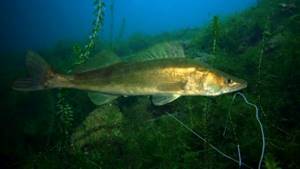
Found in large rivers, reservoirs and lakes. There are a lot of pike perch in desalinated areas of the seas, near the mouths of large rivers - the Volga, Don, Dnieper, Kuban, etc. They do not tolerate muddy and polluted water, as well as water depleted of oxygen.
An adult pike perch (weighing more than 500 g) feeds mainly on small fish, but is not averse to grabbing large worms, crayfish and other aquatic life. Keeps in packs. The larger the pike perch, the smaller the school. It grows quite quickly, reaching 12–14 cm in length in the first year.
For habitat it prefers deep, clean places with a rocky, pebble or hard sandy bottom. He especially loves holes with steep, very uneven bottoms with depths of at least 3 m, and avoids algae. Having filled his stomach with food, he rests until he digests it, hiding during this time in shelters between stones and snags.
Pike perch, especially large ones, are a very cautious and secretive fish. He is rarely tempted by large lures. More often it is caught on a rig with a gudgeon or small white fish, and even better at catching small, lively baitfish. It is considered a nocturnal predator, a dawn fish, but can also be caught during the day. Only at night and at dawn does it go out to the shallows to the shores, where small change collects, and hits it here. And during the day it lingers in holes among shelters, from where it can make rushes for prey, but very secretly, without fighting. The sounds of a pike perch fighting are characteristic - it is a loud gurgling sound, as if a cobblestone was forcefully thrown into the water or a bottom one with an excessively large sinker.
During the battle of small fish, the pike perch does not take bait, but after the battle the bite begins immediately. The time and duration of feeding of pike perch depend on many reasons, but mainly on the feeding capacity of the reservoir and the abundance of food. A hungry pike perch can hunt during the day. It does not lurk in ambush like a pike, but moves along the edges of steep slopes into the depths. As a rule, it is possible to catch three or four out of a flock, although it does not leave. They just stop taking pike perch.
You can often find concentrations of pike perch near rapids and dams, where it hunts for fish that have weakened in the fight against the current and huddled together in a patch of calm water. He is very fond of cluttered pools and holes, which are adjacent to rocky, pebble or sandbanks. In reservoirs it lingers near the slopes of flooded riverbeds and ravines. On lakes it follows schools of small fish, sometimes driving them to places that are advantageous to it, rich in oxygen and adjacent to shelters. He is very mobile, often changing places.
Pike perch always sticks to the bottom and only when hunting, in pursuit of small things, does it come to the surface. Unlike perch, it does not slurp when grabbing prey.
In summer, pike perch can often be found behind a riffle - in a pool or in a river. The presence of stones, piles, cramps and drifts at the bottom contributes to the success of the search. In early spring and autumn, it stays in the quietest and deepest sections of rivers, especially if they are adjacent to rocky, pebble or sandy holes. Muddy bottom is always avoided.
On hot summer days, pike perch appear on rapids where they go out to hunt. In cloudy weather they raid rapids and shallows even during the day. With the beginning of the snow melting and settling, when the first streams of melt water fall under the ice, the pike perch comes to life. It begins to emerge from the holes to the shores, where there is a current and a depth of 3–4 m, and briefly enters the shallows. On some reservoirs it comes to life even earlier, when the sun has noticeably passed the “sun for summer, and winter for frost,” that is, when the day has arrived by an hour.
After a flood, it likes to watch for prey, which is carried to the depths of the main reservoir by streams and flowing rivulets. The condition for its ambush is a depth of at least 3 m close to such mouths with a rocky, pebble or sandy bottom.
The weather condition does not affect the pike perch bite, but in strong winds it becomes more difficult to control the gear. The pike perch is not afraid of a knock, but at the sight of a person or boat it leaves. Breaking ice with an ice pick has no effect on him either. On the contrary, fishermen have noticed that the sound of the ice pick attracts it. The places where pike perch live are fairly constant. Finding them requires fishermen endurance, perseverance and perseverance. But when a place has already been found, the catch rate is sometimes completed in 20–30 minutes.
Pike perch feeds throughout the year; feeding is reduced only in winter, before and during spawning. The best bite is observed at the end of winter, it especially improves with the beginning of snow melting, then after spawning, which coincides with the unfolding of oak leaves (on rivers) and the flowering of willow (on lakes and reservoirs). And finally, during the search for winter camps, which coincides with the autumn coloring of birch leaves. During the first ice (and the last ice), pike perch intensify their hunt for fry, for which they leave their holes. And during the feeding season, it is easy to catch, but difficult to find. However, we must also keep in mind that for most of the winter, pike perch almost stop going out to feed, hiding in their cluttered, snag-ridden fortresses - pits. At such times, they do not reveal themselves in any way, they do not react either to bait or to the most intricate baiting techniques.
Fishing techniques, as well as habitats for rivers, lakes and reservoirs, have their own characteristics. On rivers, to search for parking, flocks of pike perch use a boat to swim with the current, slightly holding its progress and directing it to places with the greatest depths and the quietest currents. They don’t avoid holes, whirlpools and waterways, and sometimes they go through them twice.
They fish with live bait on the bottom. At depths of more than 5 m, live bait can move vertically - under the boat, but even here the sinker must touch the bottom. At depths of less than 5 m, live bait is placed in front of the boat 10–12 m or more. There is no point in fishing at a depth of less than 2 m. The number of steps of a running bottom line when fishing for pike perch by swimming with live bait can vary between 8–10 per minute.
Having caught the pike perch, they return with the side above the place where the bite was, and repeat the swim. They try to more accurately notice the places of the second bite in order to anchor and organize bottom wiring from the spot. Frequent boat passages can alert pike perch and they will stop biting.
Bottom fishing at depths and uneven bottoms - in the habitats of pike perch - is most successful. Fishing with a running jig is no less successful.
For vertical trolling you also need a boat. The sheer trolling of pike perch should be ranked second in terms of success. Shining is only possible by swimming with the current. Calm or light wind weather is required. In strong winds it is difficult to control the tackle and the boat at the same time.
Summer lure does not require long pauses, 3–5 seconds is enough. Pauses are used both when lowering and when lifting, but at the top they are shorter. The main condition for success is to hold the spoon near the bottom and bait the hook of the spoon with a piece of white fish or a small whole one. Moreover, the game here should be sluggish, upward movements slow and smooth, and pauses longer. The color of the spinner is also important. Unlike other fish, pike perch is very picky and does not take chrome and nickel-plated spoons. Need silver plated or tin plated. Pike-perch spoons also differ from others in that the tee hook is suspended on a ring. Hooks soldered into the body of the spoon bring frequent catches of fish. If the spoon is used without bait, the tee is camouflaged with gray feathers or red hair. But the main difference is that the spinner is soldered from two metal plates. The pike perch has a death-like “bulldog” grip; it is so strong that the mark of its teeth remains on the lures filled with lead on one side. It is impossible to drag the spoon through when hooking and force the tee to dig into the mouth.
Spinning fishing is possible from a boat and from the shore. There are some peculiarities when catching pike perch using this method. Conventional wiring is not suitable. It is necessary to lead the spoon, or better yet, the tackle with the fish so that it or the sinker strikes the bottom and the more often the better, they do not drag, but seem to jump. To achieve the goal, step-by-step wiring of the spinner is practiced. There should be a pause of 6-7 seconds between steps. In other words, after lowering the tip of the rod and loosening the line, lifting and reeling follows, which is one step, or one step, until the tip of the rod is lowered again and the reeling stops.
Special equipment is also used to help avoid frequent snags and increase fishing success. In all cases, the movement of spinners and rigs should be slow - the pike perch does not grab fast-moving baits. A hooked pike perch should not be driven. We need to drag him into the landing net as quickly as possible. When trying to fish for a long time and the slightest weakening of the line, he throws himself behind stones, driftwood and into snags, from where he can rarely be pulled out. It resists strongly and stubbornly only at the bottom, and when raised from it, it goes almost without resistance.
They also catch pike perch using jigs. The difference between pike perch jigs is primarily in their size and weight, as well as whether they are baited with whole fish or pieces. The weight of zander jigs reaches 35 g with hook No. 10–12
For summer jig fishing, a one-handed spinning rod with a reel is most suitable. At the end of the rod (behind the tulip) a nod is placed from a 0.7 mm vein twisted in half. The scaffold should pass through the nod freely, its diameter is 0.25–0.3 mm. On a jig hook, a fish or a piece of white fish, a bunch of worms in two punctures, a crawler and a spindle are baited as bait. The best bait is fish. The fishing technique is usual.
Bottom fishing rods allow you to fish from the shore, but successful fishing can only be done at or near known pike perch sites. Lures are live bait and baby fish, in the summer - whitefish, and in the fall - brush, but the best is a gudgeon, pieces of whitefish, a bunch of worms in two punctures, a crawler and a spindle.
They are not in a hurry with hooking, giving the pike perch the opportunity to swallow the bait, but when jerking or pulling after feeding, the lines are hooked immediately.
Ice fishing for pike perch is practiced with spoons and tackle, as well as with fry. During fresh water and winter, catching pike perch is rare, its bite is uneven, but on a clear and frosty day you can count on success. The caught fish must be quickly pulled out and the bait returned to the hole. If you hesitate, the flock may leave. Collective fishing helps the cause. A large number of spinners playing can delay a flock in the fishing area for a long time. For winter flashing, the pause increases significantly and should reach 5–7 s.
The glittering technique itself is common, but there are also peculiarities of some techniques. They only flash near the bottom – 5–10 cm from it. The rise of the spinner is smooth - 20–40 cm, but sometimes the first 5–10 cm of the rise begin with acceleration, gradually reaching normal speed. They also use small swings with the tip of the fishing rod after stopping the spoon, and during the pause, continue rocking for up to 20–25 seconds. Sometimes it is useful to place the spoon on the bottom and move it, lifting the tail for 3-5 seconds, and then slowly lift it by 5-10 cm. The time the spoon rises from the bottom is the most frequent moment of bites.
You should start trolling an hour before dawn from the shallowest places, gradually moving to holes made closer to the dumps in the depths.
When fishing for pike perch at shallow depths (4–6 m), it is better to cover the holes with snow and finely crushed ice. The bite is improved by placing a fry or piece of fish on the hook of a spinner. Pike perch usually feed in the immediate vicinity of the hole, on its slopes, occasionally going out onto the adjacent shallows.
Everything that concerns the winter trolling of pike perch on rivers also applies to lakes.
Blizzards, snowfalls, strong winds, changes in water level, fluctuations in temperature and atmospheric pressure are not favorable for pike perch.
As the snow begins to melt, trickles of meltwater penetrate under the ice. The pike perch perk up and begin to emerge from the holes to hunt for small things. They approach the shores. It is here - at the exit from the holes to the rocky, pebble and sandy shallows, as well as to the mouths of tributaries - that you should make holes, looking for pike perch. The best time for ice fishing is coming.
In summer, on lakes and reservoirs, the most effective way to catch pike perch is with circles and vertical lures, but in well-known sites near the shores, a bottom fishing rod is also possible. There is enough literature about fishing with mugs.
Lure can compete with any fishing method, especially if the places where pike perch congregate are known. But Moscow fishermen have a proverb: “A body of water is not a grocery store, sometimes you’ll be left without fish.” To successfully catch pike perch, you need to know the body of water well; you cannot always go to different bodies of water in the hope of catching pike perch on the first trip.
For trolling from a boat, you need a fishing rod no longer than 80 cm. Vinyl plastic whips with a tip no thinner than 4 mm are very good. The reel is now considered necessary; it allows you to conveniently maneuver the tackle and fight on thinner line.
The pike perch spoon should not have a frisky game and large deviations to the sides when gliding. The game should be slow, lazy, with shifting at the end of planning and when stopping. Periodically, after two or three lifts, you should touch the bottom of the spoon and move it, lifting the tail. Therefore, you need heavy spoons with a small bend in the head.
In terms of color, the best spinners are made from two metal plates: the inner one is brass, the outer one is silver (silver-plated or tinned brass), but it’s not bad if both sides are silver. Spoons cannot be polished; the surface must be matte. These requirements are mandatory. The hook is a tee No. 6–10 with a short shank, painted red-orange and attached to the lure with a ring. It’s a good idea to disguise the hook with a bunch of red hairs; their ends should be no more than 5–8 mm longer than the hook.
In summer, large spoons are used, and in winter, small ones. When the boat is moving, heavy spoons are needed to feel the bottom with them. Of course, small and light spoons are more catchy. Some fishermen cast them from zinc and an alloy of lead and antimony (for hardness). The shape is blocky, reminiscent of a minnow. Games are achieved by bending the tail. The weight of such a spinner is up to 50 g. It is used on clear, sunny days in the summer in the current. Sometimes they use a tackle with a dead fish. In summer, forests of 0.3–0.4 mm are used, in winter – 0.25–0.3 mm. Its reserve should allow it to shine at depths of up to 15 m.
In reservoirs, searches for pike perch are undertaken in areas of flooded riverbeds and oxbow lakes, ravines and quarries, in deep holes littered with stones, piles and snags. When looking for steep drops into the depths, you should stick to the listed places. And searches are necessary, since the fish often moves, follows small things or looks for places with a more favorable oxygen regime.
At dawn, pike perch comes out onto rocky ridges, pebble and sandbanks, moving along steep slopes, slopes of a flooded riverbed, along ditches and ravines. Sometimes it reaches shallows 1.5–2 m deep. With the onset of darkness, the bite weakens, but does not stop, and in the fall it can be good. At dawn, the bite intensifies, weakening again with sunrise, when large and medium-sized pike perch go back into the depths, and small ones continue hunting at mid-water and at the surface until 12–14 hours.
It is very important to be able to control the boat with calculation, so as not to break away from the lure. You can do this: lower the anchor and let the boat move 10–20 m away from it, but troll, gradually moving the boat in an arc; again sail away from the anchor 10–12 m and repeat the lure, moving the boat in an arc. All this makes it easier to control the boat. This technique is especially good in strong and moderate winds.
Knowledge of the reservoir allows you to quickly find the edges and slopes of the riverbed, ravines, and move the boat along the slopes. To search for such places on an unfamiliar body of water you have to use a heavy depth gauge, which can sometimes be replaced by a detachment.
Found places suitable for pike perch must be marked on the diagram, placing permanent landmarks, like a shooting card. These patterns are especially useful when fishing from ice, since finding fish at this time will be difficult. During fishing, the found places and their bends are marked with buoys made from volleyball chambers, which can simultaneously be used as bottom fishing rods. Buoys are placed 3–5 m away from future fishing areas and do not approach them closer than 2 m in the future.
The bite is most often felt as a slight push, rarely as a jerk during the beginning of the pause. Even more often, the next time you lift the rod, you feel a heaviness, similar to a hook. Having caught a bite, you need to make an energetic (short) hook and, putting down the oar, pull out the fish. Medium and small pike perch can be grabbed by the eyes with your hand and thrown into the boat. If you come across a large one, then you need to tear it off the bottom, tire it out and take it into the landing net. Experienced fishermen, as soon as they put down their oar, manage to throw out the buoy, which helps them return to the bite site. When there is wind, the boat can sometimes be carried 15–30 m and it is difficult to find a bite spot.
You should note the depth at which the pike perch was caught, and then until the end of fishing, troll at the same depth, looking for suitable places. The best trolling depth when searching for fish will be the slope of the edge, slope - 0.5 m below the ridge, and in no case the bottom of the riverbed or pit. If a snag is found, you need to clarify its location and try to catch it in open clearings or 1.5–2 m from the edge.
On lakes, pike perch stays in depths and holes adjacent to shallows, which is especially typical in spring and autumn.
In summer, he often goes to the shallows, hunting for small things. On lakes, pike perch are especially cautious and rarely approach the boat, even at depths. Therefore, it is more often caught using bottom fishing rods with long casting or using live bait casting from a spinning rod with a sliding float. To catch pike perch on lakes in the summer, a depth of at least 5 m is required, and in the fall - 8 m. Often, fighting and chasing the pike perch after the fry, similar to the fight of a perch, but without slurping, helps to find fish. Share on social networks:
Lifestyle
It is a freshwater fish, there are two main forms - semi-anadromous and residential (sedentary). Most marine inhabitants breed at the junction of fresh river and salt sea waters. Eggs are deposited in the upper reaches of rivers. In this, semi-anadromous and sedentary pike perch are similar; both species raise their fry in the same places.
Semi-anadromous pike perch lives in salty sea water. Most often this is the Azov or Caspian Sea. The basis of the diet is bulls, saber fish and sprat. To spawn, the semi-anadromous pike perch goes into fresh water and then rises upstream. Sometimes spawning occurs near the sea.
Mainly lives in the waters of the Baltic, in the Gulf of Riga and the Gulf of Finland. The current carries pike perch to port waters, where it lives and breeds.
The size of the resident pike perch is smaller than its semi-anadromous counterpart. This is explained by the fact that the “nomadic” species needs a large amount of clean water.
For life, pike perch chooses deep areas of the reservoir, preferring snags and stones. Bottom soil should also be of high quality; areas with a lot of algae will be avoided.
Fish come to rocky, sandy areas in search of food. The time of day is not important; hunting efficiency is the same day and night. This is due to the well-developed mouth of the pike perch. He rests during the day, just a couple of hours is enough. His “bedroom” in nature is an area where there are stones and driftwood.
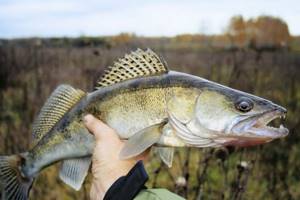
Where does it live in Russia?
Pike perch is quite common throughout Russia; most often, a representative of the perciforme order is found in the following seas and their nearest bodies of water:
- Black.
- Azovskoe.
- Aral.
- Baltic.
- Caspian.

